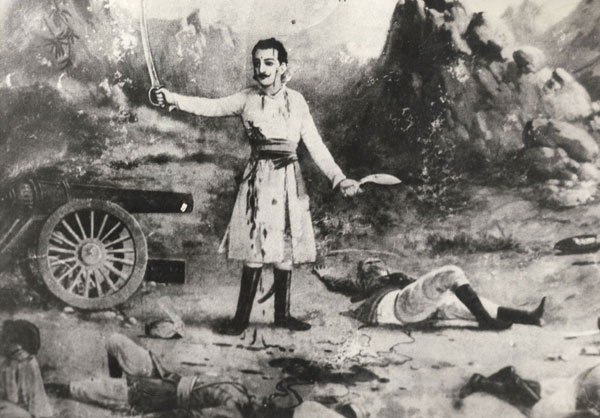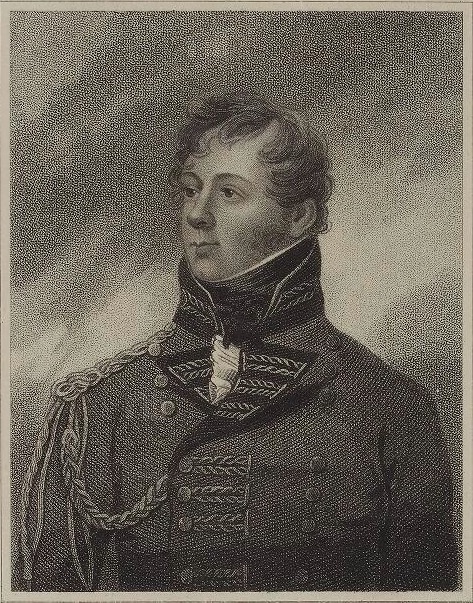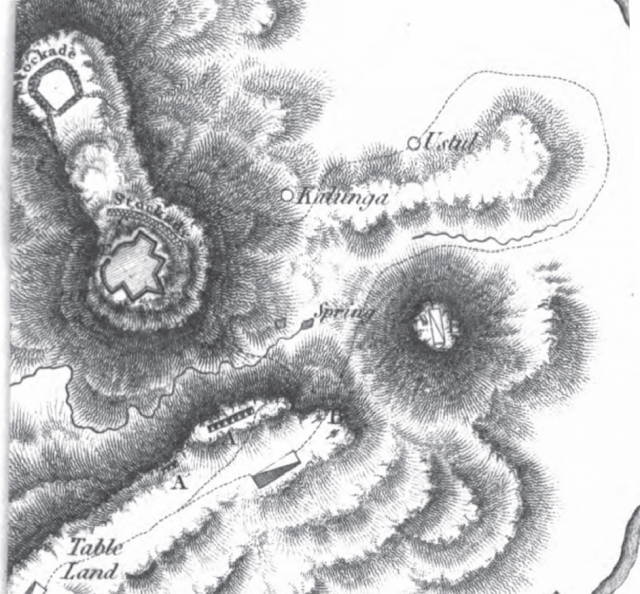
By Frank Jastrzembski
1814 was an important year in the British Empire. The Allied Sixth Coalition forces defeated the armies of Napoleon and forced him to abdicate, and the United States was at war with the British in North America. Nearly 4,000 miles away, two adversaries were struggling for power in India. The Gorkha Kingdom was at war with the British East India Company in Northern India.
The Anglo-Nepalese War of 1814-1816 was one of the British Empire’s most unspectacular military performances of the nineteenth century. The British expedition was supposed to be a demonstration of strength, but it met an unanticipated determination from the Nepalese people. Historian John Pemble stated that the Nepalese proved unimaginably resilient and the British inept beyond all expectations. In the end, Nepal was defeated, but no one could claim they had been conquered. The attack on Kalunga (Khalanga) in October of 1814 established the same myth of heroism for the Nepalese as it did for the Greeks at Thermopylae or the Siamese at Bang Rachan.
Nepalese historian Mojumdar Kanchanmoy indicated that the British East India Company had grown tired of the “nibbling encroachments and conquests” of the Nepalese Hillmen, who unremittingly harassed the British protected Indian states and their trans-Himalayan trade. For over ten years, the Nepalese audaciously pushed southwards into British territory, primarily into the disputed territory of Butwal and Sheoraj. The British East India Company chose to act and destroy their defiant neighbors once and for all.
The plans for invasion were devised by the Commander-in-Chief and Governor-General in India, Francis Edward Rawdon-Hastings, a veteran of the Battle of Bunker Hill. In October of 1814, Hastings ordered 22,000 troops to penetrate the 600-mile border of the Gorkha Kingdom that stretched across the Himalayas and bordered British-controlled Northern India. The objective would be to capture Kathmandu, the reigning capital of the Gorkha Kingdom. In essence, the thrust was an attempt to quickly cut off the seat of power and cause a rapid collapse of Nepalese leadership.

Hastings planned to cut the kingdom in half by sending two columns in a thrust to the east and two columns to the west. In the east, Major-Generals Bennet Marley and John Sullivan Wood would each lead a column by separate routes across the Tarai towards the heart of the Kathmandu Valley. Two other columns, one under Colonel David Ochterlony and the other under Major-General Robert Rollo Gillespie, were ordered to penetrate the far western hills by separate routes and concentrate to destroy the main Nepalese Army, under the command of Amar Singh Thapa. Major General Rollo Gillespie was the most celebrated officer in India at the time. Gillespie lived a charmed life, surviving a number of deadly encounters that made him legendary in the West Indies and India. The objective was to decisively engage and destroy the Nepalese Army in a pitched battle and then march unopposed into Kathmandu.
From the start, the invasion force would be plagued by numerous setbacks. The columns under Marley and Wood failed to even penetrate Nepal due to their own incompetence. Success hinged on the columns in the west, under Gillespie and Ochterlony.
Gillespie had pledged to unite with the Ochterlony’s column by November 1. When the two forces were united, Gillespie would assume overall command and concentrate in a westward thrust on Nahan. The 4,000 man column first needed to dislodge the defenders at the fort of Kalunga, located five miles to the east from the town of Dehradun. This obstacle on his flank could jeopardize his column if it were not removed. The Nepalese garrison at Kalunga was too strong for Gillespie to detach troops to contain it while still being able to send an adequate force to Ochterlony’s aid.
Less than half of the Nepalese garrison that occupied the fort could be considered soldiers. The Nepalese garrison was made up of an assortment of 600 poorly-armed Nepalese women, men, and children. It was under the command of Captain Balbhadra Kunwar, a man specially selected for his intrepidly and valor. These poorly clothed and supplied defenders lacked experience or the weapons to counter this overpowering foe. They had three elements that helped them to overcome their numerical and technological disadvantage: the surrounding rugged and impassible jungle terrain, the overconfidence of the British, and their own willingness to defend this hopeless position to the last.
The fort itself was strategically posted on a detached hill rising approximately 600 feet from the Doon Valley. The fort was composed of twelve foot high wooden double palisade walls. The flanks and rear of the fort were protected by the rocky jungle terrain, making it extremely difficult to access. It was recorded that there was not a spot available in the valley that would afford room for 1,000 soldiers to pitch their tents. The approach to the fort was also hindered by a stream that ran through a deep ravine to the front of the fortress. The most accessible route was to the south, down a stony road from Dehradun.
General Gillespie initially sent Lieutenant Colonel Sebright Mawby, an experienced and brave officer, with a small detachment to eliminate the troublesome fort. His detachment consisted of 1,300 infantry, 300 dismounted cavalry, and five light guns. When Colonel Mawby arrived, he sent a message to Captain Balbhadra Kunwar, demanding him to surrender. It was rumored that when Balbhadra Kunwar received the dispatch at midnight, he tore it up since it was against his custom to negotiate during the evening hours.
On October 24 at approximately 4:30 PM, Mawby moved his guns within range and began to shell the fort. After several hours of continuous bombardment, Mawby realized his light guns had caused little damage. He judged the position too strong to be demolished without the support of heavier artillery. Mawby sensibly withdrew his detachment to await further orders from Gillespie.
Gillespie received a dispatch from Mawby stating that he had withdrawn from the fort and was awaiting further orders. Gillespie was annoyed by what he saw as Mawby’s timidity. He did not wish to distract valuable time and manpower on this strategically unimportant fort. He feared a prolonged siege would direct his attention away from unifying his command with Ochterlony. However, he was well aware that Kalunga was an obstacle that had to be eliminated.
On October 25, he sent a message to Mawby stating that he would join him in person. He redirected his nearby forces to assemble in the city of Dehradun at all haste. He then marched this unified command through the blistering heat to arrive at Kalunga on October 26.

Gillespie knew he needed to act quickly. He spent October 27 reconnoitering the ground and the approaches to the fort. He determined that his only option would be to bombard the fortress into oblivion or to storm it by assault. Besieging the fort was discounted by Gillespie since a battering train from Delhi would take at least four-five weeks to arrive. Gillespie chose the swifter option. He was confident that his professionally trained and numerically superior force could overtake the fort.
General Gillespie wrote a letter dated October 28, well aware of the formidable opposition he faced, “Here I am, with as stiff and strong a position as ever I saw, garrisoned by men who are fighting pro aris et focis in my front, and who have decidedly formed the resolution to dispute the fort as long as a man is alive.” However, he was self-assured of victory continuing, “It will be a tough job to take it; but by the first proximo I think I shall have it, sub auspice deo!”
Similar to the successful storming tactics he implemented during the Vellore Mutiny and the British invasion of Java in 1811, Gillespie gave the direct order on October 29 to take the fortress by assault. He ordered that his infantrymen should rely exclusively on the bayonet, and to refrain from stopping to fire until within the fort’s walls. The importance of the solidity of his ranks, the bayonet, and the composure of his officers were reiterated by Gillespie.
His plan was to make a simultaneous assault by five separate columns on the fort. The discharge of five guns would provide the signal to advance, three at intervals of a minute, followed by two in rapid sequence. On October 30, the columns of Lieutenant Carpenter and Major Ludlow, under Gillespie’s supervision, constructed a forward position of batteries within 600 yards of the fortress. On October 31 at 2 AM, three columns began to move to their assigned positions in the flanks and the rear of the fort. Major Kelly moved toward the village of Kusulle (Kursalle), Captain Fast moved toward the village of Luckhand (Luckhound), and Captain Campbell moved toward Ustall (Ustul).
At sunrise, two twelve-pounders, four six-pounders, and four five-half inch howitzers engaged the fort, commencing the battle. Gillespie hoped that this bombardment would demoralize the defenders before the combined assault commenced. Within one and a half hours, it was apparent that artillery did little damage, as most of the shots fell short or flew off to the distance of the fort.
To the frustration of Gillespie supervising the bombardment, a party of Nepalese soldiers posted on an isolated hill moved to the flank of the guns and began harassing them with sporadic gunfire around 9:00 AM. Gillespie quickly ordered a howitzer to turn on the bold attackers. With the support of a bayonet charge by some of Carpenter’s and Ludlow’s infantrymen, Gillespie was easily able to scatter the small Nepalese party. The most critical error of the battle was what Gillespie did next. He impulsively ordered Carpenter and Ludlow to prepare their men to pursue the fleeing Nepalese soldiers toward the fort.
This movement caused a preeminent assault of the fort two hours before the scheduled time. If these men had broken this easily, why wouldn’t the rest of the defenders do the same? The irascible Irish general sent orders to the other column commanders to attack immediately and disregard the signal to attack. None of these orders were ever received by the three columns. Gillespie even ordered the battery to fire the premature signal, but Fast, Campbell, and Kelly never managed to distinguish it. All his life, Gillespie had acted on the principle of bold action. On this day, his pride proved his undoing.
Carpenter led 600 men toward the eastern approach of the fort, which included two companies of the Fifty-Third and 50 dismounted Royal Irish Dragoons. Ludlow led the second column composed of 136 sepoys and 50 of his own dismounted dragoons. The United 100 Dragoons were placed in front of the assaulting column, in hopes that they would shock troops. This proved to be an imprudent decision.
The impulsive and lightly-clad dragoons advanced too far ahead and became isolated from the pioneers carrying ladders, and the infantrymen weighted down by gear as they surged up the eastern slope of the hill toward the fort. The Nepalese defenders scaled the palisade walls and engaged the dragoons in hand-to-hand combat. Within minutes, 58 dragoons were wounded and four dead. The survivors fell back in disorder to nearby collection of Nepalese huts 60-80 yards from the fort. The Nepalese soldiers returned to the fort and prepared next to meet the slow moving pioneers and infantrymen.
The pioneers and infantrymen retracted the tracks of the first failed attack. They met the same fortune. They were repulsed by the defenders predominately armed with bows, stones, outdated matchlocks, and their feared curved blades, the kukri. The pioneers and infantrymen managed to place the ladders on the palisade walls before they fell back in disorder. In the chaos, the nearby huts where the demoralized attackers assembled caught fire, casing the flames to reach and burn the ladders, eliminating all hope of scaling the walls.
Gillespie became furious at the news of the repulse and the lack of support from his detached columns. At about 10:00 AM, he quickly scribbled a message to Carpenter telling him that he would personally come up to take command. The detached columns under Fast, Campbell, and Kelly were in position as ordered, patiently waiting for the signal to advance. They could hear firing in the distance, but none dared to initiate an attack. They each anxiously surveyed their pocket watches already a half an hour overdue of the scheduled assault.
At 10:30 AM, three straggling companies of the Fifty-Third Regiment arrived, and Gillespie promptly led them in an attempted to salvage the deteriorating situation. A dragoon had noticed a small opening in the northwest wall of the fort. Gillespie, Mawby, Carpenter, and Ludlow met and decided to move toward the opening and to attempt to force their way through. The smoke from the burning huts provided a screen for their movement. Balbhadra Kunwar was well aware of the gap, and beforehand barricaded it with stones and logs and placed single cannon at its entrance.
Gillespie ordered a six-pound horse artillery gun to be brought up and fired into the entrance. He had hoped it would wreck the Nepalese cannon and barricade in order for his party storm through. Once he was satisfied it was demolished, he ordered Ludlow to personally take a storming party through the opening. When within point blank range, grapeshot was unleashed into them by the Nepalese cannon crew. Women and children began to hurl stones at them from atop the palisade wall. Ludlow himself was hit the thigh by a large stone. The combination of these factors led them to waver and fall back.
The Nepalese defenders once again left their interior defenses and crashed into the demoralized attackers. They were able to overrun the six-pound horse artillery gun. Ludlow attempted to lead a counter attack, but only four men were willing to follow him amid his desperate pleas. The men had lost their vigor against an enemy that displayed such admirable fortitude. One soldier by the name of John Ship recalled he “never saw more steadiness or bravery exhibited in my life. Run they would not and of death they seemed to have no fear though their comrades were falling thick around them, for we were so near that every shot told.”
Infuriated at this repulse, Gillespie personally led the men of the Fifty-Third in a counterattack within twenty-five yards of the fortress under a sweeping fire of arrows, matchlocks and grape shot. Just before 11:15 AM, Gillespie turned to a horse gunner and fellow Ulsterman, and roared, “Now Charles. Now for the honor of Down.” A Nepali sharpshooter took advantage of the exposed Gillespie frantically wielding his sword in the air and fired an aimed shot that penetrated his heart, instantly killing him. The death of General Gillespie caused the assault to come to a halt.
Mawby assumed command and immediately ordered the attack called off. The attackers streamed to the rear in the face of the bold Nepalese defenders. Campbell held his column still as he heard the fire growing more intense, and finally relented and moved his column forward. He arrived too late as Ludlow was already overseeing the withdrawal. The battle was over. The column suffered heavily with the loss of 35 killed and 228 wounded. The body of Gillespie was retrieved by his men and was preserved in alcohol mockingly ‘pickled’ until it arrived in Meerut for burial.
Nearly a month, later on, November 24, the attack was renewed by Mawby. It was again repulsed with heavy losses. After these two failed attempts to capture the fort, the water supply was cut off placed under siege. After 29 days, the Nepalese defenders, only 68 remaining of the original 600, attempted a risky breakout. Balbhadra Kunwar and the survivors were able to fight their way through the besieging force and escape, never formally surrendering. The fort was completely dismantled and burnt to the ground, in retaliation for the staggering 31 officers and 750 men lost.
The campaign to defeat the Nepalese would drag on for 18 long months, finally ending in March of 1816. The ferocity and courage that the Nepalese defenders exhibited in the battle of Kalunga, and in the war, captivated the British officers and soldiers who were tasked with conquering this rugged region. James Baillie Fraser praised their effort stating that they fought despite their “hopelessness of relief” and fought with “unsubdued courage.” As a result of their prowess in the war against the East India Company, thousands of Nepalese hillmen were recruited in 1815 by the British to serve in their Indian Army. They became a pillar of the British Indian Army up until the independence of India in 1947.
Even though eventually victorious through the later efforts of David Ochterlony, the war was a costly endeavor for the East India Company. Pemble stated that it had failed to enhance British trade in the way Hastings had hoped. The repulse at Kalunga was a defining moment in British India. A ragtag collection of men, women, and children had shown they could defeat a professionally trained army of the British East India Company.
Two white obelisks originally placed in a cornfield have stood for roughly 200 hundred years. In a rare occurrence of honoring their adversaries, the British erected two memorials commemorating the British and the Nepalese dead from the battle. One memorialized the British Army and the death of Gillespie while the other commemorated the Nepalese defenders.
The Nepalese defenders at Kalunga did not die in vain. Their stand embodied one of the many instances where an indigenous people were able to demonstrate their ability to defy the mighty empire on which the sun never set.
By Frank Jastrzembski